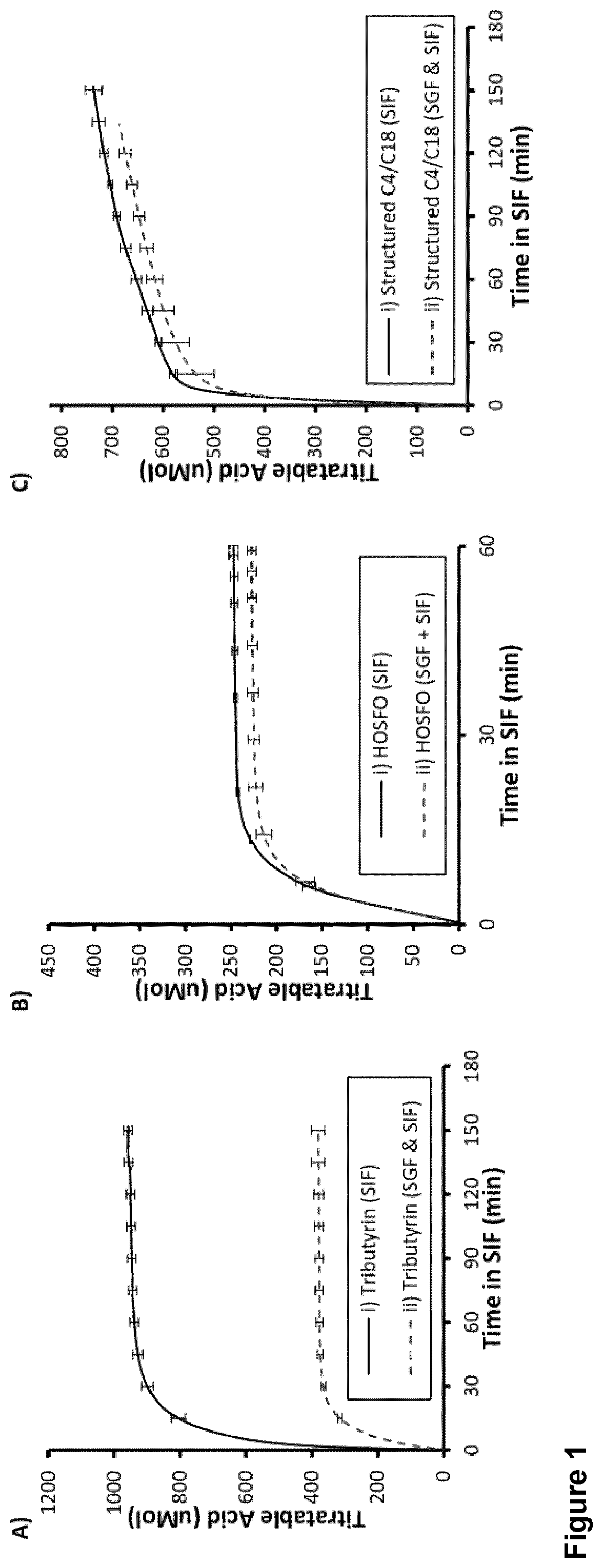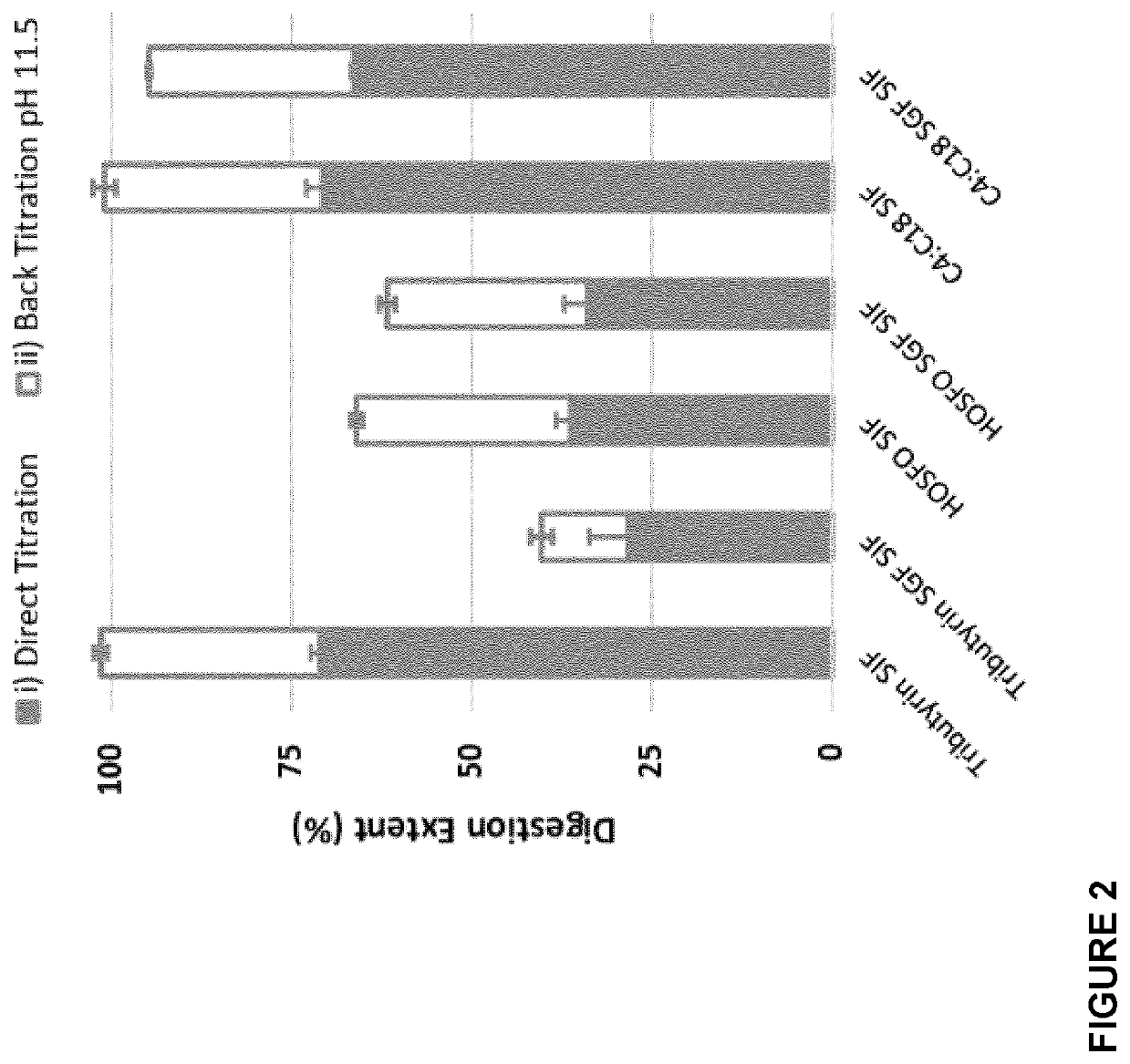Dietary butyrate
a technology of butyrate and dietary fiber, which is applied in the direction of food ingredients, animal husbandry, fatty acid chemical modification, etc., can solve the problems of no approved drug for muscle-wasting diseases, limited efficacy, and failure to completely succeed in experimental therapies previously including myoblast transplantation
- Summary
- Abstract
- Description
- Claims
- Application Information
AI Technical Summary
Benefits of technology
Problems solved by technology
Method used
Image
Examples
example 1
Preparation of Butyrated Triglycerides (TAG)
[0188]Compositions comprising butyrated TAG were generated by chemical interesterification between tributyrin and high oleic sunflower oil in the presence of catalyst such as sodium methoxyde. A molar excess of tributyrin compared to high oleic sunflower oil was be used.
[0189]The three reagents, tributyrin, high oleic sunflower oil and the catalyst were mixed together into a reactor under nitrogen atmosphere and then heat under stirring at 80° C. for 3 h. Once the reaction is completed, the product was washed several times with water then dried under vacuum (25 mBar at 60° C. for 2 h). The resulting oil product was then subjected to a decoloration step with the action of bleaching earth and was purified either by short-path distillation (130° C., 0.001-0.003 mbar) or by deodorisation (160° C., 2 mbar, 2h) with injection of steam water.
[0190]The constituents, mostly triglycerides, of the resulting oil compositions are shown below in Table 1...
example 2
Odor Properties of Butyrate Moiety Containing Triglycerides
[0193]An odor comparison of a solution including butyrate moiety containing TAG (composed mainly with oleic and butyric fatty acids) was compared to a solution containing sodium butryate.
[0194]Sample Preparation
[0195]Solutions including butyrate moiety containing TAG (see Example 1) or sodium butyrate were prepared and stored at 4° C. prior to delivery to the sensory panel. Each 250 mL solution contained 600 mg of butyric acid (equivalent to one capsule of commercially available sodium butyrate as a supplement; 2.4 mg / mL concentration) and 1% w / v BEBA Optipro 1 infant formula in acidified, deionized water.
[0196]The samples were prepared the day before the test, by putting 4 mL of each solution (TAG butyrate solution; sodium butyrate solution) in Agilent vials.
[0197]Methodology
[0198]The ‘two-out-of-five test’ was performed. In this test, the panellist is given five samples. The panellist is instructed to identify the two samp...
example 3
Taste Properties of Butyrate Moiety Containing Triglycerides
[0204]Sensory benchmarking of a solution including butyrate moiety containing TAG (see Example 1) composed mainly with oleic and butyric fatty acids was performed versus a solution containing tributyrin.
[0205]Sample Preparation:
[0206]One scoop (4.6 g) of BEBA Optipro 1 infant formula was added to warm water (cooled, boiled tap water as per instructions) to a final volume of 150 mL (approximately 3% w / v solution). Each TAG form of butyrate was weighed separately to deliver 600 mg of butyrate, and the addition of infant formula to a final volume of 50 mL for each solution was performed.
[0207]Solution A included butyrate moiety containing TAG (see Example 1); and solution B contained tributyrin.
[0208]Methodology
[0209]A group of panellists performed a repeated blind-coded tasting.
[0210]The samples were prepared just prior to the preliminary bitterness assessment, and each solution was vigorously shaken. Tasting cups labelled A ...
PUM
| Property | Measurement | Unit |
|---|---|---|
| wt % | aaaaa | aaaaa |
| wt % | aaaaa | aaaaa |
| wt % | aaaaa | aaaaa |
Abstract
Description
Claims
Application Information
 Login to View More
Login to View More - R&D
- Intellectual Property
- Life Sciences
- Materials
- Tech Scout
- Unparalleled Data Quality
- Higher Quality Content
- 60% Fewer Hallucinations
Browse by: Latest US Patents, China's latest patents, Technical Efficacy Thesaurus, Application Domain, Technology Topic, Popular Technical Reports.
© 2025 PatSnap. All rights reserved.Legal|Privacy policy|Modern Slavery Act Transparency Statement|Sitemap|About US| Contact US: help@patsnap.com



